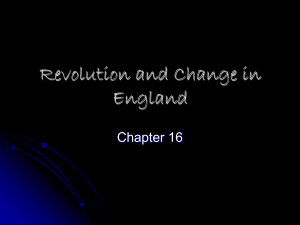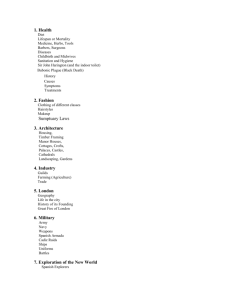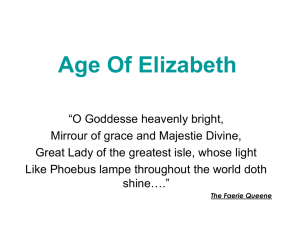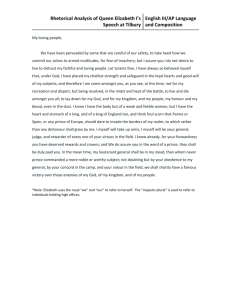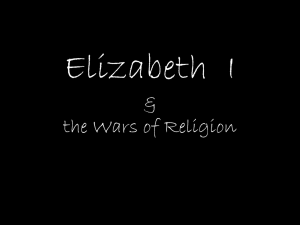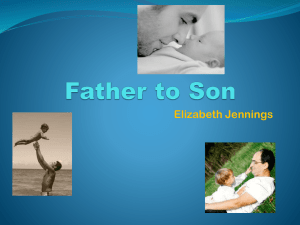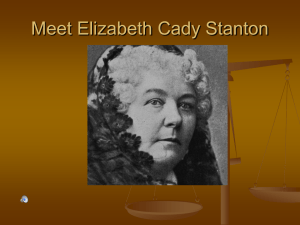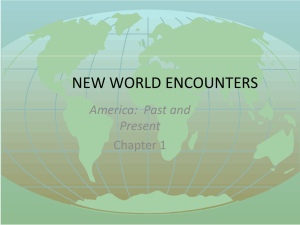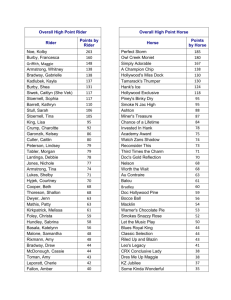File - AndAllThat.co.uk
advertisement
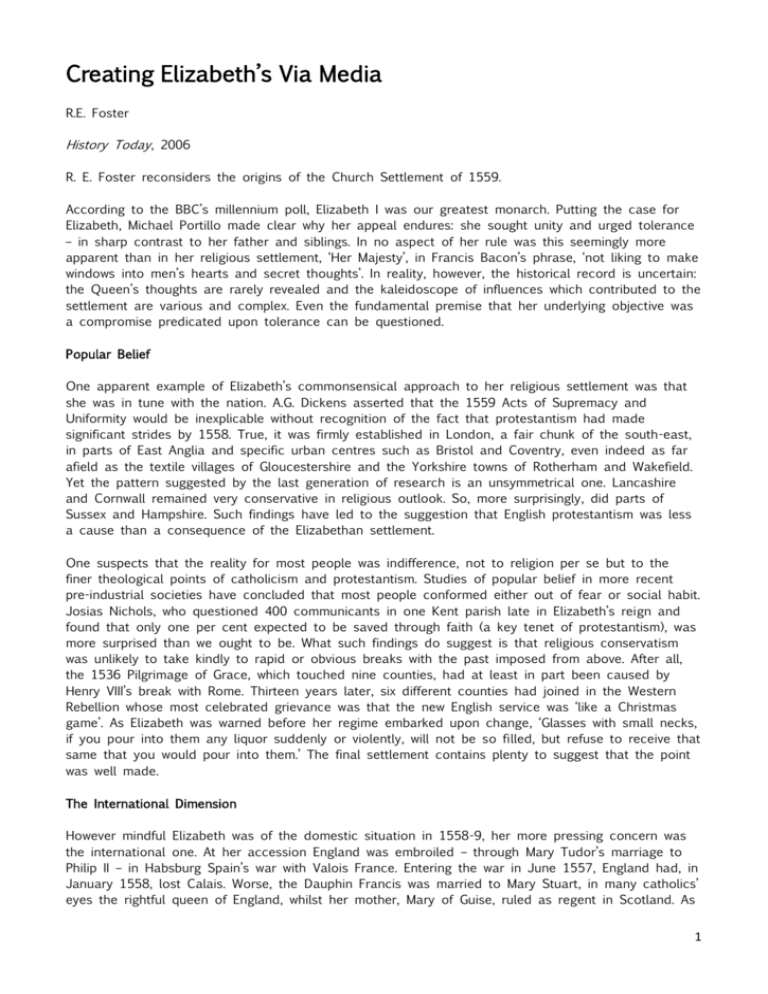
Creating Elizabeth’s Via Media R.E. Foster History Today, 2006 R. E. Foster reconsiders the origins of the Church Settlement of 1559. According to the BBC’s millennium poll, Elizabeth I was our greatest monarch. Putting the case for Elizabeth, Michael Portillo made clear why her appeal endures: she sought unity and urged tolerance – in sharp contrast to her father and siblings. In no aspect of her rule was this seemingly more apparent than in her religious settlement, ‘Her Majesty’, in Francis Bacon’s phrase, ‘not liking to make windows into men’s hearts and secret thoughts’. In reality, however, the historical record is uncertain: the Queen’s thoughts are rarely revealed and the kaleidoscope of influences which contributed to the settlement are various and complex. Even the fundamental premise that her underlying objective was a compromise predicated upon tolerance can be questioned. Popular Belief One apparent example of Elizabeth’s commonsensical approach to her religious settlement was that she was in tune with the nation. A.G. Dickens asserted that the 1559 Acts of Supremacy and Uniformity would be inexplicable without recognition of the fact that protestantism had made significant strides by 1558. True, it was firmly established in London, a fair chunk of the south-east, in parts of East Anglia and specific urban centres such as Bristol and Coventry, even indeed as far afield as the textile villages of Gloucestershire and the Yorkshire towns of Rotherham and Wakefield. Yet the pattern suggested by the last generation of research is an unsymmetrical one. Lancashire and Cornwall remained very conservative in religious outlook. So, more surprisingly, did parts of Sussex and Hampshire. Such findings have led to the suggestion that English protestantism was less a cause than a consequence of the Elizabethan settlement. One suspects that the reality for most people was indifference, not to religion per se but to the finer theological points of catholicism and protestantism. Studies of popular belief in more recent pre-industrial societies have concluded that most people conformed either out of fear or social habit. Josias Nichols, who questioned 400 communicants in one Kent parish late in Elizabeth’s reign and found that only one per cent expected to be saved through faith (a key tenet of protestantism), was more surprised than we ought to be. What such findings do suggest is that religious conservatism was unlikely to take kindly to rapid or obvious breaks with the past imposed from above. After all, the 1536 Pilgrimage of Grace, which touched nine counties, had at least in part been caused by Henry VIII’s break with Rome. Thirteen years later, six different counties had joined in the Western Rebellion whose most celebrated grievance was that the new English service was ‘like a Christmas game’. As Elizabeth was warned before her regime embarked upon change, ‘Glasses with small necks, if you pour into them any liquor suddenly or violently, will not be so filled, but refuse to receive that same that you would pour into them.’ The final settlement contains plenty to suggest that the point was well made. The International Dimension However mindful Elizabeth was of the domestic situation in 1558-9, her more pressing concern was the international one. At her accession England was embroiled – through Mary Tudor’s marriage to Philip II – in Habsburg Spain’s war with Valois France. Entering the war in June 1557, England had, in January 1558, lost Calais. Worse, the Dauphin Francis was married to Mary Stuart, in many catholics’ eyes the rightful queen of England, whilst her mother, Mary of Guise, ruled as regent in Scotland. As 1 the lawyer Armagil Waad graphically put it, Henry II of France was ‘bestriding the realm, having one foot in Calais and the other in Scotland’. Diplomacy clearly took precedence over religion. It was at least Elizabeth’s relative good fortune that the loss of Calais could be blamed on Mary Tudor and that, devoid of finances, all sides sought an end to hostilities. Talks had opened in September 1558 before Mary died. Restarted in February 1559, the Treaty of Cateau-Cambrésis was finally signed on 2 April. By its terms Elizabeth confirmed the loss of Calais, few if any clinging to the clause that France would either return it after eight years or pay an indemnity of 500,000 crowns. France also undertook to pacify the Scottish border. Such considerations, however, were not decisive since Elizabeth had already decided upon some form of protestant settlement. England’s ambassador to the papacy was recalled as early as 1 February 1559. At the same time, envoys were despatched to the Lutheran German princes who might be attracted by the prospect of alliance with a moderately protestant England. Yet calculation of Philip II’s response was critical. England gauged rightly that Philip would stomach the unease which a protestant settlement engendered because the alternative was worse. Installing Mary Stuart on the English throne was unacceptable to him because it would become all too easy for the French to cut off the Spanish Netherlands by sea. Moreover, he still harboured some hopes that he might restore Spanish influence in England by marrying Elizabeth. Far from inclining England to caution therefore, the timing of Cateau-Cambrésis perhaps made it possible to move more quickly and further in a protestant direction than might otherwise have been the case. Elizabeth’s Religion If diplomatic concerns were to some extent tangential, Elizabeth’s own religious preferences – and how far they prevailed in 1559 – have long been recognised as central to the debate on the religious settlement. Such ‘clues’ as she offered to her own beliefs were invariably calculated. In March 1559 she told Feria, the Spanish ambassador, that she ‘resolved to restore religion as her father left it’, but this was at a time when she wished to reassure his royal master. Less than two months previously the same correspondent had been sufficiently anxious as to write that ‘the Catholics are very fearful of the measures to be taken in this parliament’. Doubtless he had heard of what had happened on Christmas Day 1558 when Elizabeth had stormed out of her chapel following Bishop Oglethorpe’s elevation of the Host (the consecrated communion wafer), contrary to her instructions. Assessments of the Queen’s religion have ranged from her being a crypto-catholic on the one hand to a convinced protestant on the other. Any claims to a definitive verdict err beyond the evidence, which points to an idiosyncratic personal faith. As the product of the Henrician Supremacy she was virtually bound to reject papal authority, but beyond that her predilections are ambiguous and even contradictory. The teenage Elizabeth had been tutored by those sympathetic to the new learning, yet she felt able to take mass in Mary’s reign. Insofar as she was protestant, it was of the Lutheran variety which believed in some sort of real presence at communion, but which fell short of the catholic doctrine of transubstantiation. By 1559 this made her conservative by mainstream Calvinist standards. On some points her protestant orthodoxy was more suspect still: she kept a cross in the royal chapel until at least 1586 and retained the services of Thomas Tallis as a chapel organist although he was a known catholic. She was convinced neither by the rectitude of clerical marriage nor the merits of too many sermons. When all is said and done, however, it was a settlement of a fundamentally protestant nature which emerged in her reign. It is inconceivable that Elizabeth would have sanctioned anything to which she was fundamentally opposed, even if she was prepared to surrender over what she considered to be peripheral detail. Counsel and Councillors 2 One way in which Elizabeth could not but reveal something of her religious hand early on was in royal appointments. Those 50 or so physically closest to the Queen in the Chamber were characterised chiefly for having served Edward VI rather than Mary. It is the Privy Council, however, that demands greatest attention as effectively the ruling board of Tudor England. Elizabeth reconstituted Mary’s unwieldy body of 39 Privy Councillors into a more manageable 19. Of these, half had served Mary. Although staunch catholics were omitted, men such as the earls of Arundel, Shrewsbury and Derby, who had welcomed Mary’s restoration of the mass, owned too many acres to risk alienation. Others, like Lord Treasurer Winchester and Sir William Petre, offered administrative acumen which it was impolitic to dispense with. Yet it is the promotions which surely tell us most. The Earl of Bedford, a firm protestant, was a Marian exile. So too was Sir Francis Knollys who had served Edward VI. At least two others, Sir Edward Rogers and William Parr, had been implicated in Wyatt’s rebellion of 1554. Above all in terms of importance was Sir William Cecil, a more moderate protestant, whom Elizabeth had appointed surveyor of her estates in 1550. He resumed the office of Secretary which he had enjoyed under Northumberland. Though this was not a council constructed for religious purposes, it unquestionably had a protestant hue and was a clear move away from the previous reign. That said, we are left with the question of what role the council played in formulating the religious settlement. The problem, once again, is rendered intractable through lack of evidence. We do not know how often it met to discuss the issue, neither who attended, nor how its members divided. We do know that it did not speak with one voice, for both Winchester and Shrewsbury were to vote with the minority on the Act of Uniformity in April 1559. We do know, though, that Cecil was the key figure, ‘the man who does everything’, according to Feria in December 1558, and that his closest associate was his brother-in-law, Sir Nicholas Bacon. We also know that Elizabeth quickly came to regard him as indispensable since, late in 1559, she gave way when he threatened resignation unless she agreed to his plans for a more forward policy in Scotland. For all her guile and intelligence it must also be recognised that Elizabeth was inexperienced in government. It is reasonable to conclude that she must have sometimes deferred to those who were not. John Jewel certainly believed so, writing on 20 March that the failure to produce a fully protestant settlement could be ascribed ‘partly to her own friends, by whose advice everything is carried on’. The key unknowns in the story of the settlement can in all probability be explained in the unrecoverable deliberations of the Privy Council. Parliament One general fact admitting of no dispute is that the settlement was enacted through parliament. Parliament had been Henry VIII’s chosen ally over the break with Rome; it had enacted the Edwardian Reformation and overturned it under Mary. It had only baulked when it came to restoring monastic land, since many members had acquired some. On this point even Mary had had to be pragmatic and climb down. But since Elizabeth was as keen to exploit church revenues as anybody there was no reason to suppose that parliament would not comply in principle with whatever she and her government proposed. Yet parliament was not immutable. The Commons was a substantial body of 400 MPs, far more than the crown could directly control. A certain degree of autonomy was inevitable; Sir John Neale argued that it was critical. Neale believed that Elizabeth simply sought to restore the royal supremacy in 1559. Instead, MPs seized the initiative, in particular returned protestant exiles Sir Francis Knollys and Sir Anthony Cooke, and successfully introduced a Bill providing for a protestant prayer book too. This is 3 ingenious but untenable. Only a dozen members were returned exiles and the number of known protestant members (25-30) was more or less cancelled out by the number of known religious conservatives. Far more, just over 100 MPs, had sat in Mary’s last parliament. The mood may have been more protestant in 1559 than it had been in 1558 but there are no grounds for seeing a grand conversion. As for Knollys, he was a privy councillor whilst Cooke was Cecil’s and Bacon’s father-in-law! It is difficult to see how they can have been initiating anything other than a government line. Lord Keeper Bacon’s speech at the opening of parliament that MPs had gathered for the ‘making of laws for the ... uniting of the people of this realm into a uniform order of religion’, seems also to imply that it was clearly the Queen’s intention to go beyond a mere restoration of the supremacy. The Commons might contribute to, but it could not control, the debate. On the face of it, the Lords would be even more amenable to government control. They were a much smaller body, nominally comprising about 77 members, though only 40-45 regularly attended. The majority were the 50 or so lay members, who, led by the councillors in their midst, could reasonably be expected to follow royal policy. Elizabeth had already added five loyalists to their number before parliament opened. Less malleable were the 28 Marian bishops who could hardly be presumed upon to endorse a second break from Rome. Fortunately for Elizabeth, death, illness and absence meant that only 13 were able to take their seats at the opening of parliament. It would not appear, therefore, that the government anticipated any insurmountable opposition to its plans from their lordships. Yet in the event, a combination of bishops and conservative lay peers in the upper House were to influence the story of the settlement far more than had been presumed. Making the Settlement Though the 1559 settlement was subsequently to be hailed by many as cautious and incomplete, what was more striking at the time was its speed and extent. Elizabeth’s three predecessors had effected their reformations piecemeal over time; hers was complete within four months. Parliament opened on 25 January. A Bill restoring the royal supremacy was laid before the Commons on 9 February. On 16 February a second Bill appeared which effectively proposed restoring the 1552 Prayer Book. By 21 February the two Bills were subsumed into one, which passed the House two days later and was sent to the Lords. All this smacks of smooth royal parliamentary management. If so, it was a lull before the storm. Led by the bishops, the Lords emasculated the proposals: references to the order of service were deleted and though they conceded that Elizabeth might take the Supremacy they refused to bestow it. Thus amended the measure returned to the Commons on 18 March. They passed it on 22 March: only the royal assent was needed to make it law. Historians have seen the next few days as something of a mini-crisis. The government had surely presumed that its own proposals would be enacted into statute at this point and that parliament would be dissolved, probably on 22 March. Elizabeth instead had to choose: parliament could be dissolved with or without giving her consent to the emasculated proposals; or, it could be prorogued. She decided on the prorogation over Easter, the decision being announced on 24 March. We cannot say for certain if she reached this judgement alone or whether she was persuaded, perhaps by Cecil. Still less can we be sure of the reasoning behind it. News that agreement had been reached at Cateau-Cambrésis, however, arrived in England on 19 March. The safer international outlook which this presaged may well have stiffened royal resolve. This woman, excellent as she is ... notwithstanding she desires a thorough change as early as possible, cannot however be induced to effect such change without the sanction of law; lest the matter should seem to have been accomplished, not so much by the judgement of discreet men, as in compliance with the impulse of a furious multitude. Over Easter two of the leading opponents of change, the bishops of Winchester and Lincoln, were imprisoned for disobedience following a public disputation in Westminster Abbey. When parliament 4 reassembled on 3 April new and revised Bills of Supremacy and Uniformity were presented. The former proposed designating Elizabeth ‘Supreme Governor’, placating protestants as well as catholics who doubted that a woman could be head of Christ’s church. The latter revived the 1552 Prayer Book but incorporated conservative elements from that of 1549. Clerical dress and church ornaments were to be those in use in 1548 (Archbishop Parker was to recollect that Elizabeth had personally insisted upon this), and offensive references to the pope were omitted, as was the Black Rubric which contained an explicit denial of the real presence. Indeed, by amalgamating the communion formulary of 1549 with that of 1552, it became possible for conservatives to maintain that one was implied. The Commons passed the two Bills unchanged. In the Lords the Supremacy Bill passed comfortably on 26 April and the all-important division on the Bill of Uniformity was carried by 21-18 on 28 April. The closeness of the vote suggests that this time the government had got its sums right. The bishops were allowed to salve their consciences but the Queen got her settlement. All bar one were subsequently deprived. On 8 May the two Bills received the royal assent and parliament was dissolved. Conclusion ‘It requireth great cunning and circumspection’, Armagil Waad had warned, ‘both to reform religion and to make unity between the subjects.’ By May 1559 the first at least had been achieved. There was, as it turned out, remarkably little to add except for a series of 57 royal injunctions issued in the summer of 1559 and a statement of doctrine, the 39 Articles, agreed by Convocation in 1563. On the latter point, however, there could be no quick fix. A return in 1564 of magistrates – the allimportant officials of law enforcement – revealed that although 431 backed the settlement, 264 were neutral and 157 hostile. It would take a generation to protestantise the commissions of the peace. Amongst the clergy too, there was a shortage, both qualitative and quantitative, which Elizabeth seemed in no hurry to make good. This may suggest that toleration after all was what Elizabeth sought. Not so. As Cecil so appositely put it, ‘the state could never be in safety, where there was toleration of two religions’. Elizabeth’s genius lay in recognising that a broader church than Edward and Mary had allowed was essential, providing it was one to which the nation must be loyal. At the close of the momentous 1559 parliament Lord Keeper Bacon issued a warning, doubtless at his Queen’s behest, to anybody who might doubt that fact: ‘Amongst those I mean to comprehend as well those that be too swift, as those that be too slow; those, I say that go before the laws, as those that will not follow; for good government cannot be where obedience faileth’. These were not idle words. Those rebels who joined the northern earls in 1569-70 were visited with a retribution comparable to anything dispensed by any Tudor. Further Reading Patrick Collinson, Elizabethans (Hambledon & London, 2003) A. G. Dickens, The English Reformation (Batsford, second edition, 1989) Susan Doran, Elizabeth I and Religion 1558-1603 (Routledge, 1994) Christopher Haigh, English Reformations (Clarendon Press, 1993) Christopher Haigh (ed.), The Reign of Elizabeth I (Longman, 1984) Wallace T. MacCaffrey, Elizabeth I (Edward Arnold, 1993) J. E. Neale, Elizabeth I and Her Parliaments 1559-1581 (Jonathan Cape, 1953) John Warren, Elizabeth I: Religion and Foreign Affairs (Hodder and Stoughton, 1993) Issues to Debate o What was the religion of the English people in 1558? o How important was it to Elizabeth that her views prevailed in the 1559 religious settlement? 5

